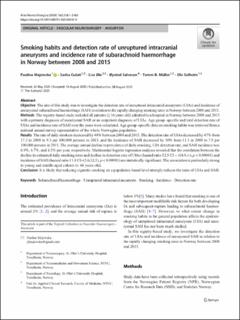| dc.contributor.author | Majewska, Paulina Luiza | |
| dc.contributor.author | Gulati, Sasha | |
| dc.contributor.author | Øie, Lise Rystad | |
| dc.contributor.author | Salvesen, Øyvind | |
| dc.contributor.author | Müller, Tomm Brostrup | |
| dc.contributor.author | Solheim, Ole | |
| dc.date.accessioned | 2021-04-26T13:12:10Z | |
| dc.date.available | 2021-04-26T13:12:10Z | |
| dc.date.created | 2020-11-02T22:39:11Z | |
| dc.date.issued | 2020 | |
| dc.identifier.citation | Acta Neurochirurgica. 2020, 162 (12), 3161-3165. | en_US |
| dc.identifier.issn | 0001-6268 | |
| dc.identifier.uri | https://hdl.handle.net/11250/2739672 | |
| dc.description.abstract | Objective
The aim of this study was to investigate the detection rate of unruptured intracranial aneurysms (UIAs) and incidence of aneurysmal subarachnoid haemorrhage (SAH) in relation to the rapidly changing smoking rates in Norway between 2008 and 2015.
Methods
The registry-based study included all patients (≥ 16 years old) admitted to a hospital in Norway between 2008 and 2015 with a primary diagnosis of aneurysmal SAH or an outpatient diagnosis of UIAs. Age group–specific and total detection rate of UIAs and incidence rate of SAH over the years were calculated. Age group–specific data on smoking habits was retrieved from a national annual survey representative of the whole Norwegian population.
Results
The rate of daily smokers decreased by 48% between 2008 and 2015. The detection rate of UIAs decreased by 47% from 17.3 in 2008 to 9.3 per 100,000 persons in 2015, and the incidence of SAH decreased by 30% from 11.3 in 2008 to 7.9 per 100,000 persons in 2015. The average annual decline in prevalence of daily smoking, UIA detection rate, and SAH incidence was 6.9%, 6.7%, and 4.3% per year, respectively. Multinomial logistic regression analyses revealed that the correlation between the decline in estimated daily smoking rates and decline in detection rate of UIAs (hazard ratio 52.5 CI = (14.9,∞), p < 0.00001) and incidence of SAH (hazard ratio 11.8 CI=(5.6,32.5), p < 0.00001) are statistically significant. The association is particularly strong in young and middle-aged cohorts (< 66 years old).
Conclusion
It is likely that reducing cigarette smoking on a population-based level strongly reduces the rates of UIAs and SAH. | en_US |
| dc.language.iso | eng | en_US |
| dc.publisher | Springer | en_US |
| dc.rights | Navngivelse 4.0 Internasjonal | * |
| dc.rights.uri | http://creativecommons.org/licenses/by/4.0/deed.no | * |
| dc.title | Smoking habits and detection rate of unruptured intracranial aneurysms and incidence rate of subarachnoid haemorrhage in Norway between 2008 and 2015 | en_US |
| dc.type | Peer reviewed | en_US |
| dc.type | Journal article | en_US |
| dc.description.version | publishedVersion | en_US |
| dc.source.pagenumber | 3161-3165 | en_US |
| dc.source.volume | 162 | en_US |
| dc.source.journal | Acta Neurochirurgica | en_US |
| dc.source.issue | 12 | en_US |
| dc.identifier.doi | 10.1007/s00701-020-04541-0 | |
| dc.identifier.cristin | 1844331 | |
| cristin.ispublished | true | |
| cristin.fulltext | original | |
| cristin.qualitycode | 1 | |

